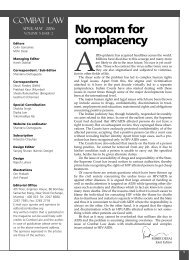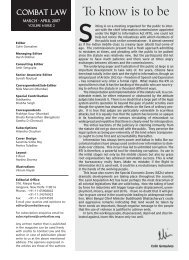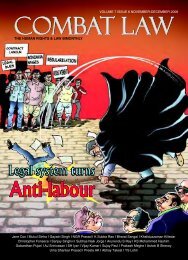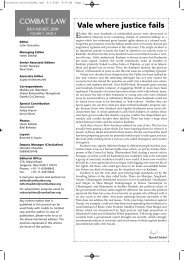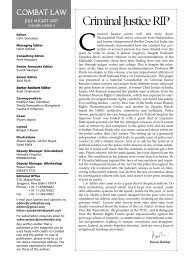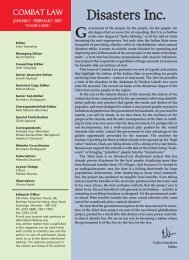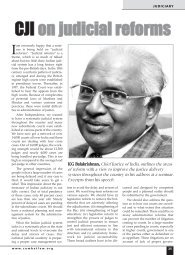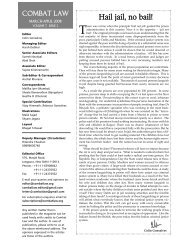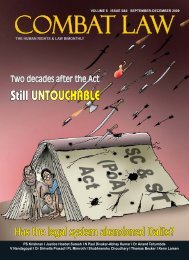PDF, 1.1MB - Combat Law
PDF, 1.1MB - Combat Law
PDF, 1.1MB - Combat Law
Create successful ePaper yourself
Turn your PDF publications into a flip-book with our unique Google optimized e-Paper software.
BY RITA VOHRAWhy and how toensure criticalengagement withthe institutionsof governance onbehalf of the 392 million children ofIndia, constituting 40% of the populationof this country, from the childrights perspective? Can governmentalinstitutions and elected representativesbe held accountable? After alla child does not have a political face.Children have no way of directlyarticulating their rights and entitlementsleave alone questioning thegaps between rhetoric and reality.They have no control over theresources in relation to their differentneeds. And yet in any democracy,it is critical to hold governmentsaccountable for what they have orhave not done for their citizens.The state’s responsibilitiesemanate from the rights approach(e.g., Fundamental Right ofElementary Education) as well asthe functional approach (securityfrom hunger and starvation, equalopportunity for all, etc.). How is thestate performing its role? How tohold it accountable? One way wouldbe to monitor its budget. Budgets area reflection of a government’s politicalcommitments. The parliamentdeliberates and passes the budgetbut how to find out whether therehas been any trade-offs within thesocial sector given the pressures ofglobalisation and privatisation? Is itthat the child component of thebudget also forms one of the softareas that is getting sacrificed?This is what HAQ: Centre for ChildRights has been attempting to do thelast four years and it has found someof its assumptions to be correct andchild rightsHolding GovernmentsAccountablemeaningful. What prompted HAQ totake action? Why does HAQ believethat engagement with institutions ofgovernance is the right step in thedirection of achieving children’srights? Indeed HAQ’s attempts havebeen to explore methodologies thatwill enable child rights activists andperhaps children themselves to monitorplanning and implementation,and may be also ask some questionsof the government.As one goes deeper into the needfor giving voice to child rights, onerealises the importance of governmentalintervention in ensuring it.But, it is also well understood by nowthat human rights of children areeasily overlooked and violated. Thistakes place in every strata of societythough this is not to deny that povertyis a compounding factor evenwhile the questions of their health,education, development and protectionare being addressed through differentgovernmental schemes.The budget of any country is notmerely an economic document. It isan indicator of its priorities andintent and the state’s role in socioeconomicdevelopment. The budgetis an estimate of the resources thatwill be available during the financialyear and the object for which theresources will be spent. It is however,not merely a statement of estimatedreceipts and expenditure; it isthe annual financial plan, a vital toolfor not only meeting the administrativeneeds but also for securing publicsocio-economic goals. Budget forchildren is not a separate budget. Itis merely an attempt to disaggregatefrom the over all allocations made,those made specifically for programmesthat benefit children. Thisenables us to assess how far the policyand programme commitments25 combat law • April - May 2004are translated into financial commitments.This would also indicatepolitical commitment of the governmenttowards its young citizens.India had presented its report tothe UN Committee on the Rights ofthe Child. This report was submittedon 19 March 1997. Based on thepresentations made by the governmentand the NGOs, the Committeemade its concluding observations.Time and again the Committee hasstressed on the need for the stateparty to take all necessary measures,including allocation of therequired resources (i.e., human andfinancial) and ensure appropriatedistribution of resources at the central,state and local levels, andwhere needed, within the frameworkof international cooperation. Itfelt that the state party shoulddevelop ways to establish a systematicassessment of the impact ofbudgetary allocations on implementationof child rights and to collectand disseminate information inthis regard. India presented its secondreport (First Periodic Report2001) to the Committee, and it cameup for review on 21 January 2004.The Committee once again reiteratedits concerns regarding budgetsfor children in its ConcludingObservations (CRC/C/15/Add.2.28.30 January 2004)With the worsening of income distributiondue to globalisation and agreater move towards privatisationof basic services such as health, education,the shrinking of the publicsector, it has to be emphasised that itis the primary responsibility of thestate to allocate resources for ensuringprotection of child rights. As perArticle 4 of CRC the States Partiesare the duty bearers. The state commandshold over resources, directly



